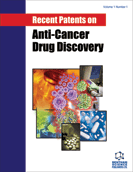Abstract
Background: Bromodomain and Extra Terminal (BET) family of bromodomain proteins (BRDs), comprised of four members in humans (BRD2, BRD3, BRD4, and BRDT), has emerged as a promising new cancer target class for small-molecule drug discovery.
Objective: This review discusses the patent literature of BET inhibitors (2010-2017) for the treatment of cancer and other related diseases.
Method: BET proteins act as ‘epigenetic readers' and bind to acetylated lysine residues on the tails of histones H3 and H4. Inhibition of BET proteins for a wide array of therapeutic applications has led to the discovery and development of various BET inhibitors.
Results: The increasing significance of BET inhibitors as a potential anticancer therapeutic has led to an extensive patent activity both from academia and pharmaceutical industry. Several of the BET inhibitors are under clinical development for the treatment of various kinds of cancers.
Conclusion: The unmet needs and challenges associated with BET inhibition for cancer treatment have been portrayed in this review. An insight into the current developments and future prospects has been described as well.
Keywords: BET, BET inhibitors, BRDs, cancer, epigenetics, patent, therapeutic potential.
Recent Patents on Anti-Cancer Drug Discovery
Title:BET Inhibitors as Anticancer Agents: A Patent Review
Volume: 12 Issue: 4
Author(s): Imran Ali, Gildon Choi*Kwangho Lee*
Affiliation:
- Bio-Organic Science Division, Korea Research Institute of Chemical Technology, Daejeon 34114,Korea
- Bio-Organic Science Division, Korea Research Institute of Chemical Technology, Daejeon 34114,Korea
Keywords: BET, BET inhibitors, BRDs, cancer, epigenetics, patent, therapeutic potential.
Abstract: Background: Bromodomain and Extra Terminal (BET) family of bromodomain proteins (BRDs), comprised of four members in humans (BRD2, BRD3, BRD4, and BRDT), has emerged as a promising new cancer target class for small-molecule drug discovery.
Objective: This review discusses the patent literature of BET inhibitors (2010-2017) for the treatment of cancer and other related diseases.
Method: BET proteins act as ‘epigenetic readers' and bind to acetylated lysine residues on the tails of histones H3 and H4. Inhibition of BET proteins for a wide array of therapeutic applications has led to the discovery and development of various BET inhibitors.
Results: The increasing significance of BET inhibitors as a potential anticancer therapeutic has led to an extensive patent activity both from academia and pharmaceutical industry. Several of the BET inhibitors are under clinical development for the treatment of various kinds of cancers.
Conclusion: The unmet needs and challenges associated with BET inhibition for cancer treatment have been portrayed in this review. An insight into the current developments and future prospects has been described as well.
Export Options
About this article
Cite this article as:
Ali Imran , Choi Gildon *, Lee Kwangho*, BET Inhibitors as Anticancer Agents: A Patent Review, Recent Patents on Anti-Cancer Drug Discovery 2017; 12 (4) . https://dx.doi.org/10.2174/1574892812666170808121228
| DOI https://dx.doi.org/10.2174/1574892812666170808121228 |
Print ISSN 1574-8928 |
| Publisher Name Bentham Science Publisher |
Online ISSN 2212-3970 |
Related Books
 121
121 20
20 1
1 1
1
- Author Guidelines
- Bentham Author Support Services (BASS)
- Graphical Abstracts
- Fabricating and Stating False Information
- Research Misconduct
- Post Publication Discussions and Corrections
- Publishing Ethics and Rectitude
- Increase Visibility of Your Article
- Archiving Policies
- Peer Review Workflow
- Order Your Article Before Print
- Promote Your Article
- Manuscript Transfer Facility
- Editorial Policies
- Allegations from Whistleblowers
Related Articles
-
Outcome Measures for Clinical Trials in Interstitial Lung Diseases
Current Respiratory Medicine Reviews Fabrication of Multi-functionalized Gold Nanoparticles and the Application to Electrochemical Detection of Nitrite
Current Nanoscience Impact of Drug Metabolism/Pharmacokinetics and their Relevance Upon Salviabased Drug Discovery
Current Drug Metabolism Subject Index To Volume 9
Current Medicinal Chemistry Seeking the 5th Base of DNA Using Chromatographic Methods of Analysis
Current Organic Chemistry Effects of Hyperlipidemia and Cardiovascular Diseases on Proliferation, Differentiation and Homing of Mesenchymal Stem Cells
Current Stem Cell Research & Therapy Protein Kinase B/AKT and Focal Adhesion Kinase: Two Close Signaling Partners in Cancer
Anti-Cancer Agents in Medicinal Chemistry Graphical Abstracts
Letters in Organic Chemistry Arachidonic Acid Induces the Migration of MDA-MB-231 Cells by Activating Raft-associated Leukotriene B4 Receptors
Clinical Cancer Drugs Bonafide Targets of Deregulated microRNAs in Non-Small Cell Lung Cancer as Tool to Identify Novel Therapeutic Targets: A Review
Current Pharmaceutical Design HPLC Analysis of Phenolic Acids, Antioxidant Activity and in vitro Effectiveness of Green and Roasted Caffea arabica Bean Extracts: A Comparative Study
Anti-Cancer Agents in Medicinal Chemistry Natural Hydrogels Applied in Photodynamic Therapy
Current Medicinal Chemistry HER2-targeted Therapeutic Strategies for HER2-positive Metastatic Breast Cancers
Current Cancer Therapy Reviews NLRP3 Promotes Colorectal Cancer Cell Proliferation and Metastasis via Regulating Epithelial Mesenchymal Transformation
Anti-Cancer Agents in Medicinal Chemistry Synthesis and Photobiological Properties of Bromo- and Alkoxymethyl Furocoumarins
Letters in Drug Design & Discovery Construction of an Anti-IL-1β scfv and TNFRI Fusion Protein and Its Therapeutic Effect on RA Mice Model
Current Pharmaceutical Biotechnology Macrocyclic Histone Deacetylase Inhibitors
Current Topics in Medicinal Chemistry Oleacein. Translation from Mediterranean Diet to Potential Antiatherosclerotic Drug
Current Pharmaceutical Design Recent Patents on Live Bacteria and their Products as Potential Anticancer Agents
Recent Patents on Anti-Cancer Drug Discovery The Potential and Rationale for COX-2 Inhibitors in Lung Cancer
Anti-Cancer Agents in Medicinal Chemistry


























